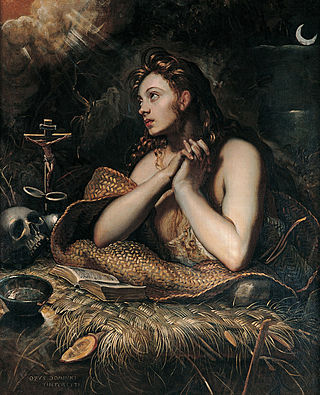
Mary Magdalene was a woman who, according to the four canonical gospels, traveled with Jesus as one of his followers and was a witness to his crucifixion and resurrection. She is mentioned by name twelve times in the canonical gospels, more than most of the apostles and more than any other woman in the gospels, other than Jesus's family. Mary's epithet Magdalene may be a toponymic surname, meaning that she came from the town of Magdala, a fishing town on the western shore of the Sea of Galilee in Roman Judea.
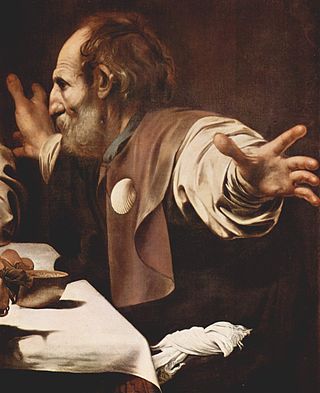
Cleopas, also spelled Cleophas, was a figure of early Christianity, one of the two disciples who encountered Jesus during the Road to Emmaus appearance in Luke 24:13–32.

In Christianity, a disciple is a dedicated follower of Jesus. This term is found in the New Testament only in the Gospels and Acts. Originating in the ancient Near East, the concept of a disciple is an adherent of a teacher. Discipleship is not the same as being a student in the modern sense; a disciple in the ancient biblical world actively imitated both the life and teaching of the master. It was a deliberate apprenticeship which made the fully formed disciple a living copy of the master.

In Christian tradition, the Four Evangelists are Matthew, Mark, Luke, and John, the authors attributed with the creation of the four canonical Gospel accounts. In the New Testament, they bear the following titles: the Gospel of Matthew; the Gospel of Mark; the Gospel of Luke; and the Gospel of John.

The life of Jesus is primarily outlined in the four canonical gospels, which includes his genealogy and nativity, public ministry, passion, prophecy, resurrection and ascension. Other parts of the New Testament – such as the Pauline epistles which were likely written within 20 to 30 years of each other, and which include references to key episodes in the life of Jesus, such as the Last Supper, and the Acts of the Apostles, which includes more references to the Ascension episode than the canonical gospels also expound upon the life of Jesus. In addition to these biblical texts, there are extra-biblical texts that make reference to certain events in the life of Jesus, such as Josephus on Jesus and Tacitus on Christ.

Emmaus is a town mentioned in the Gospel of Luke of the New Testament. Luke reports that Jesus appeared, after his death and resurrection, before two of his disciples while they were walking on the road to Emmaus.

Bleib bei uns, denn es will Abend werden, BWV 6, is a cantata by Johann Sebastian Bach for use in a Lutheran service. He composed it in Leipzig in 1725 for Easter Monday and first performed it on 2 April 1725.

The Adoration of the Shepherds is the traditional name for a New Testament episode in the story of Jesus's nativity, which is the subject of many works of art. In it shepherds are near witnesses to Jesus's birth in Bethlehem, arriving soon after he is actually born. The episode is recounted, or at least implied, in the Gospel of Luke and follows on from the annunciation to the shepherds, in which the shepherds are summoned by an angel to the scene of the birth. Like the episode preceding it, the adoration is a common subject in art, where it is often combined with the Adoration of the Magi. In such cases it is typically just referred to by the latter title.
Supper at Emmaus is an event in the Gospel of Luke.

The Supper at Emmaus is a painting by the Italian Baroque master Caravaggio, executed in 1601, and now in London. It depicts the Gospel story of the resurrected Jesus's appearance in Emmaus.

In the New Testament, the Sanhedrin trial of Jesus refers to the trial of Jesus before the Sanhedrin following his arrest in Jerusalem and prior to the trial before Pontius Pilate. It is an incident reported by all three Synoptic Gospels of the New Testament, while the Gospel of John refers to a preliminary inquiry before Annas. The gospel accounts vary on a number of details.

Matthew 28:9 is the ninth verse of the twenty-eighth chapter of the Gospel of Matthew in the New Testament. This verse is part of the resurrection narrative. Mary Magdalene and "the other Mary" are leaving the empty tomb of Jesus after encountering an angel, and in this verse they encounter the risen Jesus.

In Eastern Orthodox Christian tradition the Myrrhbearers are the individuals mentioned in the New Testament who were directly involved in the burial or who discovered the empty tomb following the resurrection of Jesus. The term traditionally refers to the women who came with myrrh to the tomb of Christ early in the morning to find it empty. Also included are Joseph of Arimathea and Nicodemus, who took the body of Jesus down from the cross, anointed it with myrrh and aloes, wrapped it in clean linen, and placed it in a new tomb. In Western Christianity, the women at the tomb, the Three Marys or other variants are the terms normally used.

Matthias Stom or Matthias Stomer was a Dutch, or possibly Flemish, painter who is only known for the works he produced during his residence in Italy. He was influenced by the work of non-Italian followers of Caravaggio in Italy, in particular his Dutch followers often referred to as the Utrecht Caravaggists, as well as by Jusepe de Ribera and Peter Paul Rubens. He did not share the other Northern Caravaggisti's preference for humorous, and sometimes scabrous, genre scenes and elaborate decorative allegories but favored stories from the bible instead. He worked in various locations in Italy where he enjoyed the patronage of religious institutions as well as prominent members of the nobility.
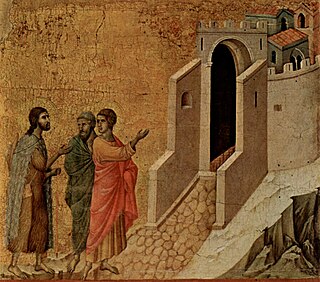
According to the Gospel of Luke, the road to Emmaus appearance is one of the early post-resurrection appearances of Jesus after his crucifixion and the discovery of the empty tomb. Both the meeting on the road to Emmaus and the subsequent supper at Emmaus, depicting the meal that Jesus had with two disciples after the encounter on the road, have been popular subjects in art.

In Christian theology and ecclesiology, the apostles, particularly the Twelve Apostles, were the primary disciples of Jesus according to the New Testament. During the life and ministry of Jesus in the 1st century AD, the apostles were his closest followers and became the primary teachers of the gospel message of Jesus. There is also an Eastern Christian tradition derived from the Gospel of Luke that there were seventy apostles during the time of Jesus' ministry.
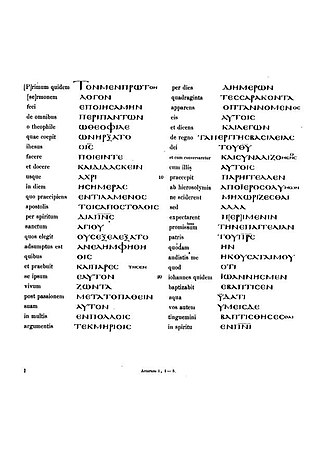
Acts 1 is the first chapter of the Acts of the Apostles in the New Testament of the Christian Bible. The book containing this chapter is anonymous, but early Christian tradition affirmed that Luke composed this book as well as the Gospel of Luke. This chapter functions as a transition from the "former account" with a narrative prelude, repeated record of the ascension of Jesus Christ with more detail and the meeting of Jesus' followers, until before Pentecost.

The Rockox Triptych or Epitaph of Nicolaas Rockox and His Wife Adriana Perez is a triptych painted by the Flemish painter Peter Paul Rubens between 1613 and 1615. It is in the collection of the Royal Museum of Fine Arts Antwerp.

The Incredulity of Saint Thomas is an oil painting on canvas by Matthias Stom, created c. 1640-1649. It is held in the Museo del Prado, in Madrid.
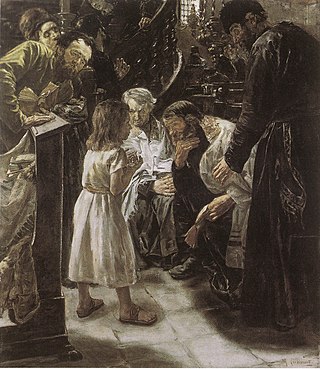
The Twelve-Year-Old Jesus in the Temple is an oil-on-canvas painting by German painter Max Liebermann, created in 1879. It is held at the Hamburger Kunsthalle.


















